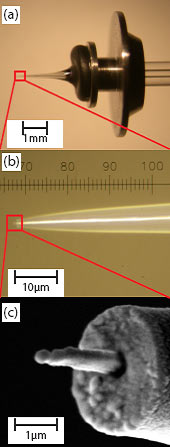Investigation of thermal near-fields with a UHV scanning thermal microscope
Effects of thermal near-field radiation are presently gaining increasing importance for the study of surface processes. In this area, the use of near-field heat transfer mediated by evanescent modes is opening up far-reaching new possibilities. On the basis of a protoype of a UHV scanning thermal microscope previously developed in Oldenburg, this project, conducted jointly by an experimental and a theoretical group, focusses on the physical mechanisms underlying the near-field heat transfer. Its primary experimental goals include the fabrication and precise characterization of miniaturized thermosensors, and measurement of the dependence of the near-field heat flux on the distance between sensor and probe, on the temperature difference, and on properties of the respective materials. The theoretical group concentrates on developing a model capable of explaining the measured data. While presently planar probes are being considered, it is planned to also analyze microstructured probes at a later stage. Particularly interesting possibilities of "thermal management" in microstructures may emerge by exploiting coupled surface plasmons in coated materials. Based on the formalism of fluctuating electrodynamics, we have given a detailed discussion of such effects. Moreover, the phenomenon of near-field heat transfer is closely related to the Casimir effect. There has been an extended debate in the literature recently concerning the thermal corrections to the Casimir force. A part of our theoretical activities is devoted to the clarification of this fundamental issue, thus preparing future projects on Casimir forces in microscience.
 [1] Thermal radiation and near-field energy density of thin metallic films
[1] Thermal radiation and near-field energy density of thin metallic films
Svend-Age Biehs, Daniel Reddig, and Martin Holthaus
Eur. Phys. J. B 55, 237-251 (2007).
[2] Thermal radiation, near-field energy density, and near-field radiative heat transfer of coated materials
Svend-Age Biehs, Eur. Phys. J. B 58, 423-431 (2007).
[3] Near-field heat transfer in a scanning thermal microscope
A. Kittel, W. Müller-Hirsch, J. Parisi, S.-A. Biehs, D. Reddig, and M. Holthaus, Phys. Rev. Lett. 95, 224301 (2005).
Figure:
a) Glass capillary with the embedded platinum wire glued into the tip holder of the scanning tunnelling microscope (STM)
b) Optical micrograph of the glass capillary with the embedded platinum wire
c) Electron micrograph of the STM tip already covered with gold forming the thermocouple. The protruding platinum wire is in direct contact with the evaporated gold film







